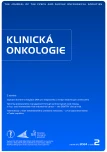Tebentafusp in the treatment of metastatic uveal melanoma – the first patient treated in the Czech Republic
Authors:
M. Klabusay 1; B. Bábková 2
Authors‘ workplace:
Onkologická klinika LF UP a FN Olomouc
1; Oční klinika LF UP a FN Olomouc
2
Published in:
Klin Onkol 2024; 37(2): 134-138
Category:
Case Reports
doi:
https://doi.org/10.48095/ccko2024134
Overview
Background: Uveal melanoma is a rare cancer, in which metastases occur in approximately one half of cases. In metastatic disease, the prognosis is unfavorable and the median of survival does not exceed 6 months. Effective treatment options were very limited up to date. Tebentafusp is a bispecific fusion protein, which as the first drug proved efficacy in uveal melanoma. Case: The patient was referred for suspected uveal melanoma of the left eye. She was treated for Hodgkin’s disease in the past. Primarily, the tumor was treated by radiosurgery with radiotherapy of a small lesion of the vertebral body. However, later the patient had to undergo bulbus enucleation with confirmation of a large tumor category pT4b. PET/CT revealed metastases of the bones and the liver; simultaneously, haplotype A*02: 01 was confirmed. The patient underwent radiotherapy of the sternum and later, after confirmation of payment from the health insurance company, she started treatment with tebentafusp. The first three doses were administered during admission to the hospital, with a need to treat cytokine release syndrome by corticosteroids. Later, the administration was performed in an out-patient regimen, without complications, except for a transient elevation of transaminases. The first CT restaging confirmed stable disease; however, the second restaging confirmed a new osteolytic lesion in the processus of Th11. Because of progression, the treatment with tebentafusp was withdrawn after 6 months. Unfortunately, the lesion could not be treated by radiotherapy. Two months later, the patient was urgently admitted to the hospital because of right-sided hemiplegia; MRI revealed bleeding metastatic lesion in the brain stem. Conclusion: In this case report, we present the case of the first patient treated with this drug in the Czech Republic.
Keywords:
treatment – uveal melanoma – tebentafusp
Sources
1. Rantala ES, Hernberg MM, Piperno-Neumann S et al. Metastatic uveal melanoma: the final frontier. Prog Retin Eye Res 2020; 90: 101041. doi: 10.1016/j.preteyeres.2022.101041.
2. Chen LN, Carvajal RD. Tebentafusp for the treatment of HLA-A *02: 01-positive adult patients with unresectable or metastatic uveal melanoma. Expert Rev Anticancer Ther 2022; 22 (10): 1017–1027. doi: 10.1080/14737140.2022.2124971.
3. Howlett S, Carter TJ, Shaw HM et al. Tebentafusp: a first--in-class treatment for metastatic uveal melanoma. Ther Adv Med Oncol 2023, 15: 1–12. doi: 10.1177/1758835 9231160140.
4. Nathan P, Hassel JC, Rutkowski P et al. Overall survival benefit with tebentafusp in metastatic uveal melanoma. N Engl J Med 2021; 385 (13): 1196–206. doi: 10.1056/NEJMoa2103485.
5. Reiter S, Schroeder C, Broche J et al. Successful treatment of metastatic uveal melanoma with ipilimumab and nivolumab after severe progression under tebentafusp: a case report. Front Oncol 2023; 13: 1167791. doi 10.3389/fonc.2023.1167791.
6. Hassel JC, Berking C, Forschner A et al. Practical guidelines for the management of adverse events of the T cell engager bispecific tebentafusp. Eur J Cancer 2023; 191: 112986. doi: 10.1016/j.ejca.2023.112986.
Labels
Paediatric clinical oncology Surgery Clinical oncologyArticle was published in
Clinical Oncology

2024 Issue 2
Most read in this issue
- Significance of aberrant DNA methylation for cancer diagnostics and therapy
- Tailoring postoperative management through sentinel lymph node biopsy in low- and intermediate-risk endometrial cancer – the SENTRY clinical trial
- Factors influencing overall survival and GvHD development after allogeneic hematopoietic stem cell transplantation – single centre experience
- Carcinoid syndrome with right-sided valve involvement – a case report and review of the literature
